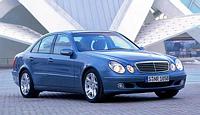100,000th Mercedes-Benz E-Class Rolls Off the Line
Steepest ramp-up ever for a Mercedes-Benz production series Dr. Schmidt: "We have further extended our global market leadership in the upper-range segment." New development and production processes will exploit further potential Stuttgart, Germany, September 03, 2002
At the Sindelfingen Customer Center, DaimlerChrysler is today handing over the 100,000th Series W 211 Mercedes-Benz E-Class vehicle. The milestone automobile is a Brilliant Silver E 320. "Thanks to the steepest ramp-up we've ever achieved for a Mercedes-Benz production series, we are today able to hand over the 100,000th E-Class vehicle to its new owner," said Plant Director Hans-Heinrich Weingarten during the presentation of the automobile. "It's an achievement of which we here at Sindelfingen are particularly proud." The 100,000th Mercedes-Benz E-Class vehicle marks a new production record, as it rolled off the line only six months after job number one. It took the company only three-and-a-half months to ramp-up production at the beginning of the year to the maximum capacity of around 1,000 vehicles a day.
E-Class captures over 25 percent of upper-range segment
"Because of the enthusiasm with which the E-Class was received on the market, we feel we have a special obligation to our customers. We will therefore do everything we can to meet their expectations and wishes," said Dr. Joachim Schmidt, Member of the Divisional Board for Mercedes-Benz Passenger Cars and smart, Head of Sales and Marketing, when the vehicle was handed over. "We will manufacture almost 200,000 E-Class vehicles this year, and meet the pleasingly high demand worldwide by expanding production to 250,000 units in 2003," he added. "Thanks to the outstanding acceptance of the vehicle on all markets, the new E-Class further extended our market leadership in the upper-range segment by capturing a global market share of over 25 percent."
Proximity of development, planning and production areas ensures optimum conditions at the Sindelfingen plant
DaimlerChrysler invested around two billion euros for the current Mercedes-Benz E-Class. About EUR 800 million was spent on the vehicle's development, while EUR 1.2 billion was expended on the production facilities at the Sindelfingen plant. In addition to the E-Class, the Sindelfingen plant manufactures the Mercedes-Benz C-, S- and CL-Classes and the Maybach. It is DaimlerChrysler's largest production facility worldwide, with a workforce of approximately 32,000. The Mercedes-Benz Technology Center (MTC), which houses the Design, Development and Testing departments with about 8,000 employees, is closely connected to the production plant. Because of the proximity of development, production planning and production to one another, the Sindelfingen location offers short distances between departments and ideal conditions for close, interdisciplinary cooperation among various business units.
Implementation of the Mercedes-Benz Development System (MDS): Development of the E-Class in only 48 months
"The challenges currently facing automobile development are to ensure the greatest amount of innovation and degree of maturity while reducing development times and costs," explains Dr. Hans-Joachim Schöpf, Member of the Divisional Board for Mercedes-Benz Passenger Cars and smart, Head of Development Mercedes-Benz Passenger Cars. "Thanks to the consistent implementation of the processes of our Mercedes-Benz Development System (MDS), we managed to tackle these challenges and develop this model from specification approval to job number one in only 48 months," says Schöpf.
The Mercedes-Benz Production System (MPS) shortens production times
By implementing the principles of the Mercedes-Benz Production System (MPS) and closely interlinking production, production planning and development early on, the Sindelfingen plant was able to reach full-scale E-Class production in just three-and-a-half months. What's more, suppliers were integrated into development and production planning at an early stage to ensure that their processes were stable as well. With the help of the plant, Production Planning built the first batch of pilot production vehicles under conditions identical to those for series production. As a result, the manufacturing process, the design of the work stations and the ergonomics of the workplaces were optimized and brought into line with the MPS.
"Planners shouldn't only make plans on paper," says Professor Eberhard Haller, Head of Production Planning Mercedes-Benz Passenger Cars. "They are also responsible for the associated technology which has to prove itself during the ramp-up phase." Despite its considerably more extensive range of standard equipment compared to the predecessor model, the new E-Class can be produced in 20 percent less time. "The Mercedes-Benz Production System fully meets its objective of improving processes, efficiency and product stage advancement," says Helmut Petri, Member of the Divisional Board for Mercedes-Benz Passenger Cars and smart, Head of Production. "What's particularly encouraging is that the MPS has found a great deal of acceptance at all levels of the company, and this is surely one of the most important factors for its success."



